What Is The Best Medicaid In Arizona
All plans in the Arizona Health Care Cost Containment System, or AHCCCS, receive the same services. There is no single optimum plan for the entire state instead, residents must choose a strategy that works best for their own county.
Regardless of which plan you choose, you will receive the same level of care and assistance.
Where Can I Upload The Documents For Arizona Medicaid
You can do it in the following ways:
Note: If youre applying for Medical Assistance for the first time, youll need to choose a health plan for each individual youre applying for. If you do not choose a plan, one will be chosen for you.
What Is The Arizona Medicaid Program
Arizona Medicaid is a state-run healthcare program supported equally by the federal government and the state.
Arizonas Medicaid organization, the Arizona Health Care Cost Containment System , provides healthcare programs to Arizona residents. Thousands of Arizonans are covered by the AHCCCS medical insurance program each year.
It assists citizens in obtaining necessary doctors appointments, physical exams, vaccines, prenatal care, hospital care, and medicines.
You May Like: Rehab Centers In Florida That Accept Medicaid
Exempt Assets For An Altcs Applicant Include:
- $2,000 or less in cash/non-exempt assets if single. If the assets exceed the limit on the first of the month the applicant is ineligible for the entire month.
- One home is exempt if planning to return, a spouse, a child under 21, or a disabled person resides in it. Whenever an institutionalized person sells a previously exempted residence, the money from the sale becomes a countable asset. The recipient may then lose eligibility for Medicaid until he/she has spent down the money and their countable resources are once again less than the maximum.
- One automobile, no equity amount specified.
- Burial spaces/plots up to 1,500 in value.
- Irrevocable burial trusts worth up to 9,000.
- Non-saleable property, household furnishings, furniture, clothing, jewelry, and other personal effects are not counted.
- Value of life insurance if face value is $1,500 or less.
ALTCS Spousal Rules:
Amount of assets community spouse may retain: The community spouse can keep non-exempt resources owned by one or both spouses with a maximum of $137,400. If the community spouses assets do not equal the minimum of $27,480, the community spouse is able to retain assets from the institutionalized spouse until the minimum is reached.
Cost And Coverage Of Medicaid In Arizona

Most people believe they receive health coverage for free, without ever having to pay a dime. While this may be true for some Medicaid recipients, most will have at least a small copay to spend at each doctor visit. Adults who have an income at above 106 percent of the federal poverty level will have mandatory copays. It could cost up to $50 for a non-emergency surgery and $75 for a hospital stay. It may cost $10 for an office visit and $4 for prescription drugs. Children and expecting mothers do not have to make these copayments.
Don’t Miss: Weight Loss Pills Covered By Medicaid
Cutbacks Of The Early 1980s
The large and expensive FSP proved to be a favorite subject of close scrutiny from both the Executive Branch and Congress in the early 1980s. Major legislation in 1981 and 1982 enacted cutbacks including:
- addition of a gross income eligibility test in addition to the net income test for most households
- temporary freeze on adjustments of the shelter deduction cap and the standard deduction and constraints on future adjustments
- annual adjustments in food stamp allotments rather than semi-annual
- consideration of non-elderly parents who live with their children and non-elderly siblings who live together as one household
- required periodic reporting and retrospective budgeting
- prohibition against using Federal funds for outreach
- replacing the FSP in Puerto Rico with a block grant for nutrition assistance
- counting retirement accounts as resources
- state option to require job search of applicants as well as participants and
- increased disqualification periods for voluntary quitters.
Electronic Benefits Transfer began in Reading, Pennsylvania, in 1984.
Who Qualifies For Ahcccs Medicaid
To be eligible for Arizona AHCCCS Medicaid, you must:
- Be an Arizona Resident and a United States citizen or qualified immigrant.
- Have, or be eligible for, a Social Security number.
- Have a limited income.
- Be a senior, age 65+, or approved for Supplemental Security Income , based on disability, by the Social Security Administration.
The gross monthly income limit as of January 2021 was $1,415 for a single applicant and $1,911 for a family of two.
for additional information on eligibility.
You May Like: Urgent Care Centers That Take Medicaid
Program Expansion: Participation Milestones In The 1960s And Early 1970s
In April 1965, participation topped half a million. Participation topped 1 million in March 1966, 2 million in October 1967, 3 million in February 1969, 4 million in February 1970, 5 million one month later in March 1970, 6 million two months later in May 1970, 10 million in February 1971, and 15 million in October 1974. Rapid increases in participation during this period were primarily due to geographic expansion.
Unitedhealthcare Senior Care Options Plan
UnitedHealthcare SCO is a Coordinated Care plan with a Medicare contract and a contract with the Commonwealth of Massachusetts Medicaid program. Enrollment in the plan depends on the plans contract renewal with Medicare. This plan is a voluntary program that is available to anyone 65 and older who qualifies for MassHealth Standard and Original Medicare. If you have MassHealth Standard, but you do not qualify for Original Medicare, you may still be eligible to enroll in our MassHealth Senior Care Option plan and receive all of your MassHealth benefits through our SCO program.
Don’t Miss: Local Eye Doctors That Accept Medicaid
Apply For Ahcccs Medical Assistance/kidscare
If you are waiting for your application to be processed or you are not eligible for AHCCCS medical assistance, you may qualify to receive drug and alcohol and mental health treatment services through other funding sources administered by the Regional Behavioral Health Authority . For more information, contact the RBHA in your area: Central Arizona at 800-564-5465 Northern Arizona at 800-322-8670 Southern Arizona at 866-495-6738.
What Services Are Covered By Medicaid In Arizona
Regarding what is covered by Medicaid, services are available to different patients through several types of Medicaid insurance plans. Arizona Medicaid coverage takes care of basic healthcare services, like visits to the doctor, lab work, X-rays, immunization shots, prescription drugs , hospital Medicaid services, pregnancy care, emergency care, transportation to the doctor, specialist care, physical exams, surgery services, family planning services and behavioral health.
Children age 21 and under receive Medicaid coverage in Arizona that includes vision exams and glasses, hearing exams and hearing aids, along with dental screenings and dental treatments. Now that you are familiar with the basic Medicaid services covered in Arizona, it is equally important to understand what is not covered by this plan.
Read Also: Does Idaho Medicaid Cover Vision
Mickey Leland Childhood Hunger Relief Act
- eliminating the shelter deduction cap beginning January 1, 1997
- providing a deduction for legally binding child support payments made to nonhousehold members
- raising the cap on the dependent care deduction from $160 to $200 for children under 2 years old and $175 for all other dependents
- improving employment and training dependent care reimbursements
- increasing the FMV test for vehicles to $4,550 on September 1, 1994 and $4,600 on October 1, 1995, then annually adjusting the value from $5,000 on October 1, 1996
- mandating asset accumulation demonstration projects and
- simplifying the household definition.
Oregon Medicaid Health Experiment And Controversy

In 2008, Oregon decided to hold a randomized lottery for the provision of Medicaid insurance in which 10,000 lower-income people eligible for Medicaid were chosen by a randomized system. The lottery enabled studies to accurately measure the impact of health insurance on an individual’s health and eliminate potential selection bias in the population enrolling in Medicaid.
A sequence of two high-profile studies by a team from the Massachusetts Institute of Technology and the Harvard School of Public Health found that “Medicaid coverage generated no significant improvements in measured physical health outcomes in the first 2 years”, but did “increase use of health care services, raise rates of diabetes detection and management, lower rates of depression, and reduce financial strain.”
The study found that in the first year:
Read Also: Can I Have Medicaid And Private Insurance
Acas Medicaid Eligibility Expansion In Arizona
Arizona accepted federal funding for Medicaid expansion under the leadership of former Governor Jan Brewer, a Republican. Largely as a result of Medicaid expansion, the states uninsured rate dropped from 17.1% in 2013 to 10% in 2016. It climbed over the next few years, reaching 11.3% in 2019, but that was in line with the nationwide increase in the uninsured rate under the Trump administration .
Federal poverty level calculator
The proposal was partially approved in January 2019, allowing Arizona to implement the following changes:
But the Trump administration did not approve all of Arizonas proposals. Notably:
Income Requirements For Arizona Medicaid
The Federal Poverty Level helps to determine eligibility for Medicaid in Arizona. Both individuals and families who fall at or below 138 percent of the poverty level may be eligible to receive state insurance. A single adult cannot make more than $16,643 per year if they hope to qualify. A family of four can make up to $33,948 and still qualify.
You May Like: If I Have Medicaid Do I Have Dental Insurance
Unitedhealthcare Connected General Benefit Disclaimer
This is not a complete list. The benefit information is a brief summary, not a complete description of benefits. For more information contact the plan or read the Member Handbook. Limitations, copays and restrictions may apply. For more information, call UnitedHealthcare Connected® Member Services or read the UnitedHealthcare Connected® Member Handbook. Benefits, List of Covered Drugs, pharmacy and provider networks and/or copayments may change from time to time throughout the year and on January 1 of each year.
You can get this document for free in other formats, such as large print, braille, or audio. Call Member Services, 8 a.m. – 8 p.m., local time, Monday – Friday . The call is free.
You can call Member Services and ask us to make a note in our system that you would like materials in Spanish, large print, braille, or audio now and in the future.
Language Line is available for all in-network providers.
Puede obtener este documento de forma gratuita en otros formatos, como letra de imprenta grande, braille o audio. Llame al Servicios para los miembros, de 08:00 a. m. a 08:00 p. m., hora local, de lunes a viernes correo de voz disponible las 24 horas del día,/los 7 días de la semana). La llamada es gratuita.
Puede llamar a Servicios para Miembros y pedirnos que registremos en nuestro sistema que le gustaría recibir documentos en español, en letra de imprenta grande, braille o audio, ahora y en el futuro.
Arizona Appeals Court Rules Against Gop Lawsuit Claiming Mail
The appeal was filed by the Arizona Republican Party and party chairwoman Kelli Ward against new Secretary of State Adrian Fontes, as well as county recorders and election officials from Arizona counties.
On Tuesday, the Arizona Court of Appeals ruled unanimously to affirm a lower courts decision to dismiss a lawsuit from the Arizona Republican Party and Chairwoman Kelli Ward challenging the states mail-in voting system, saying it violates the states constitution in regards to “secrecy in voting.”
In the courts opinion, issued by Judge Cynthia J. Bailey, she wrote that “When the Arizona Constitution was adopted, the definitions of ‘secrecy’ included ‘the state or quality of being hidden concealment,'” according to a 1912 version of the New Websterian Dictionary.
The same dictionary read that “‘Preserve’ definitions included ‘to keep from injury defend uphold save keep in a sound state.'”
“Thus, the Secrecy Clauses meaning is clear: when providing for voting by ballot or any other method, the legislature must uphold voters ability to conceal their choices. The constitution does not mandate any particular method for preserving secrecy in voting,” wrote Bailey.
Bailey continued on to say that the states main-in voting laws “preserve secrecy in voting by requiring voters to ensure they fill out their ballot in secret and seal the ballot in an envelope that does not disclose the voters choices.”
Recommended Reading: Does Medicaid Cover Life Flight
About The Arizona Health Care Cost Containment System
Founded in 1982, the Arizona Health Care Cost Containment System is Arizona’s Medicaid program, a federal health care program jointly funded by the federal and state governments for individuals and families who qualify based on income level.
Built on a system of competition and choice, AHCCCS is a $22 billion program that operates under an integrated managed care model, through a Research and Demonstration 1115 Waiver. Contracted health plans coordinate and pay for physical and behavioral health care services delivered by more than 120,000 health care providers to more than 2.5 million Arizonans.
In 2022, AHCCCS celebrated its 40th anniversary. This brief history of AHCCCS highlights the program’s many accomplishments and changes throughout the years.
- Mission: Reaching across Arizona to provide comprehensive, quality health care to those in need.
- Vision: Shaping tomorrow’s managed care…from today’s experience, quality and innovation.
- Values: Passion, Community, Quality, Respect, Accountability, Innovation, Teamwork, Leadership, and Courage
- Credo: Our first care is your health care.
Temporary Benefits Increase From April 2009 To November 2013
SNAP benefits temporarily increased with the passage of the American Recovery and Reinvestment Act of 2009 , a federal stimulus package to help Americans affected by the Great Recession of 2007. Beginning in April 2009 and continuing through the expansion’s expiration on November 1, 2013, the ARRA appropriated $45.2 billion to increase monthly benefit levels to an average of $133. This amounted to a 13.6 percent funding increase for SNAP recipients.
This temporary expansion expired on November 1, 2013, resulting in a relative benefit decrease for SNAP households on average, benefits decreased by 5 percent. According to a Center on Budget and Policy Priorities report, the maximum monthly benefit for a family of four dropped from $668 to $632, while the maximum monthly benefit for an individual dropped from $200 to $189.
Don’t Miss: When Does Medicaid End For A Child In Nc
Pilot Food Stamp Program
The 18 years between the end of the first FSP and the inception of the next were filled with studies, reports, and legislative proposals. Prominent US senators actively associated with attempts to enact a food stamp program during this period included George Aiken, Robert M. La Follette Jr., Hubert Humphrey, Estes Kefauver, and Stuart Symington. From 1954 on, US RepresentativeLeonor Sullivan strove to pass food-stamp program legislation.
Hunger continued for the poor people of the country even after the Great Depression ended, but advocacy to reinstate the food stamp program was generally unsuccessful while the political agenda did not require it. Until 1961 when President John F. Kennedy took office, there were few pilot programs in place to help America’s poor.
Of the program, US Representative Leonor K. Sullivan of Missouri asserted, “…the Department of Agriculture seemed bent on outlining a possible food stamp plan of such scope and magnitude, involving some 25 million persons, as to make the whole idea seem ridiculous and tear food stamp plans to smithereens.”
What Is The American Indian Health Program

AHCCCS members who are American Indians and Alaska Natives have the option to receive their health care coverage from the AHCCCS American Indian Health Program .
AIHP is only available to members of federally recognized tribal nations. AIHP members who are enrolled in an American Indian Medical Home have access to a nurse case manager who can help members find health and social services in the state.
AIHP members always have the option to switch their coverage from AIHP to an AHCCCS managed care plan of their choice. See a list of managed care plans. If there is an error in your enrollment, or you wish to switch AHCCCS enrollment, login to www.healthearizonaplus.gov or call or . For more information, see the AIHP member handbook.
Behavioral health residential facilities are responsible for helping members arrange non-emergency medical transportation home for members who are discharged. If you need additional assistance in arranging a ride home, please see this list of transportation companies that are approved by tribes. If you do not see your tribe on this list, please contact any of the companies on the list to arrange transportation.
Don’t Miss: Dc Medicaid Customer Service Number
